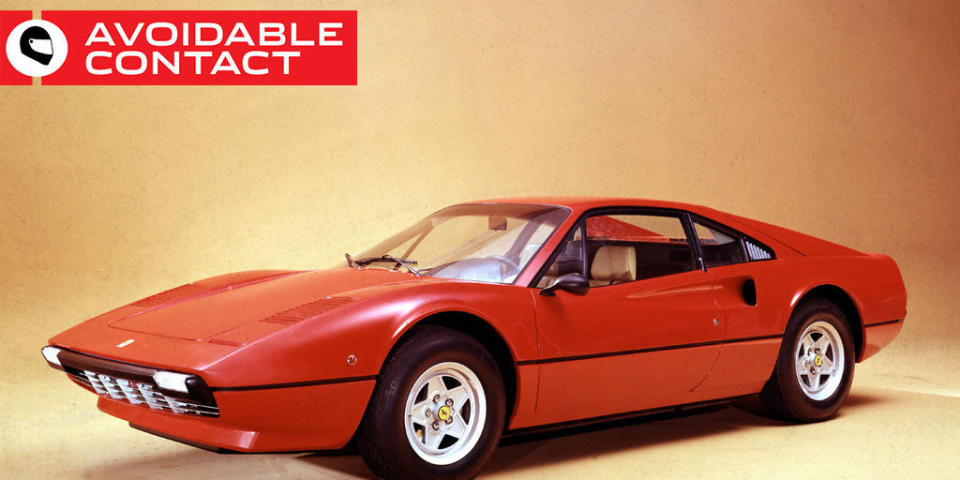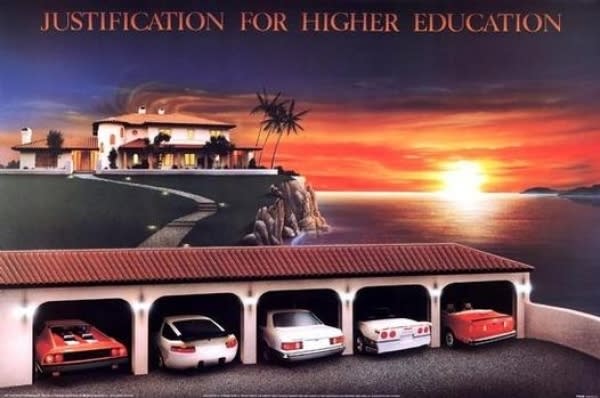How Long Will the Classic Sports-Car Bubble Last?

As I rolled into the hotel parking lot, not-so-fresh from a miserable 96-mile sportbike ride in conditions varying from "light rain" to "Helen Hunt watching a cow fly by the windshield of a pickup," I saw what I thought was a Ferrari 365 Berlinetta Boxer, and I stopped dead in the middle of the road to get a better look. Turns out that it wasn't a Boxer; rather, it was a 308 Quattrovalvole in that two-tone "Boxer" paint scheme that recently made a reappearance of sorts on the 458 Speciale.
Turns out that the 308QV owner was part of the group I was meeting for dinner that night. The next day, I joined him for a quick drive around some rural Ohio two-lanes. "The car really comes alive on roads like this," he noted. I had to agree. In fact, by the end of the night I had authentic used-Ferrari fever, of the sort that only affects me every 10 years or so.
I have a friend with plenty of experience working on mid-engined Ferraris, and over the years he's owned more than a few 308s. Typically he buys them in the mid-$20,000 range, fixes what needs fixing, and sells them in the high 30s or low 40s. I haven't seen a 308 in his shop for a few years, so I figured I'd take a look at the classifieds and see what I could get for under 50 grand. Most of the 308s sold here were targa tops thanks to the pernicious influence of the otherwise outstanding show Magnum, P.I., but I've always been more fond of the Berlinetta steel-roof coupes. Surely I could get a decent Quattrovalvole coupe for 50 grand?
If you've looked at vintage Ferrari pricing lately, then you're already laughing out loud at my ignorance. The entry point for a well-maintained 308 GTSi eight-valve car is $65k. A QV GTB coupe? I found four. One was listed at $135,000. Another was $160,000 or best offer. The other two just said, "Inquire for pricing," as if they were 250GTOs stored in hermetically sealed bubbles or something.
"Of course," one of my dinner companions had remarked the night before, "a 250GTO was once just a used car." The same is true of the front-engined Daytona coupe and convertible, which used to litter the back page of Road & Track classifieds for about the same price as a new Corvette but which now regularly threaten the million-dollar mark. That wasn't supposed to happen to the 308GT4 Dino and its descendants, which were built and sold in numbers far exceeding any other Ferrari in history. Not only are they common, but they're also pretty slow; my wife's Cobb-tuned Fiesta ST will cheerfully dust any V8 Ferrari from the era that isn't wearing flared fenders and a GTO badge.
You can make almost exactly the same arguments regarding the Porsche 911 Carrera 3.2, which sold in unprecedented numbers during the Eighties and which can't stay in front of a Toyota Camry V6. Yet air-cooled 911s, even the crummy ones, are currently selling for unheard-of prices. Ten years ago, I passed up all sorts of 911SCs for 11 or 12 grand. Those same cars are now selling for $30,000. Carreras with the G50 transmission are doubling that. And if a 1984 Porsche with 100,000 miles on it is worth 60 grand, surely the Ferrari from the same era is worth more.
Any day now, somebody is going to pay six figures for a maintenance-deferred 348ts Targa
A lot of people are calling the current surge in sports-car pricing a "bubble." It has all the hallmarks of a traditional asset-price bubble like the one that ravaged the Ferrari-spectator market 30 years ago. Everything costs more than it did five years ago, and that includes stuff that has typically been sale-proof, like early Testarossas and 550 Maranellos. Any day now, somebody is going to pay six figures for a maintenance-deferred 348ts Targa. If I recall my youthful readings of the King James Bible correctly, the minute the check clears on the aforementioned 348 deal, the sky will turn dark and the oceans will turn to blood. And not a minute too soon.
All of that being said, I can't help but note the fact that none of the prices paid for classic Ferraris at the height of the previous "speculator bubble" would be anything but a staggeringly brilliant investment by today's standards. Anybody who was "stupid" enough to pay six million bucks for a GTO back then can get five or six times that much for it now. As an investment, you'd have been better off buying stock in Apple, but not even the most fascinating securities portfolio gets invited to Goodwood or Monterey. So the old saying might be right: You can't pay too much for a Ferrari or an air-cooled Porsche. You can only buy it a little too soon. Fifty years from now, even my ragged-out, low-option '95 Porsche 993, veteran of a thousand autocrosses, impromptu freeway races, and full-throttle runs through the Hocking Hills, will be worth an embarrassing amount of money. Thank God I won't be around to have to make the choice between selling and keeping it.
There's just one little problem with the above scenario: It makes the assumption that a generation still unborn will care about cars in general and gasoline-powered cars from before their birth in particular. Do you, the statistically average 50-year-old, well-educated, car-savvy reader of this magazine, give much of a damn about Hupmobiles or Hispano-Suizas? How about accordions? Do you like accordions? They were once the most popular musical instrument in America, but you can't give them away now. So what makes us think that the middle-aged man of the year 2067 will care about your Ferrari 308 or my Fender Custom Shop Jazzmaster?
Certainly there will be some market adjustment the very minute that the median Baby Boomer can't actually get in and operate a sports car of any type, and another market adjustment when they start dying or disappearing into the nursing homes. My compatriots in Generation X just don't have as much wealth as our parents did, and we won't be falling over ourselves to bid for your father's Ferrari 355 or Porsche 964 RS America. We'll be facing medical bills of our own.

Some of that will be balanced out by Gen-Xers in finance or tech or law who have been waiting their whole lives to build a real-life diorama of those "Justification For Higher Education" posters that everybody put up in their dorms, but I don't think there will be enough demand to support current value levels for all those cars that the Boomers own. So if you manage to live another 20 or 30 years, you might have a chance to buy a Countach for under a quarter-million bucks. Lucky you! Wait until you try to parallel park it.
In the short term, however, I don't see prices for mid-engined Ferraris and air-cooled Porsches going anywhere but up. Which means that now is the time to buy. Go ahead and pull the trigger on that Rosso Corsa 308GTSi that you've wanted ever since you saw Tom Selleck driving one on television. Fire up the home-equity line of credit and add an '88 Carrera Coupe to the fleet. Try to pick one without the ridiculous Turbo-Look package, not that anybody short of Larry Ellison can afford a Turbo-Look nowadays. The worst thing that can happen is that you don't make money on the car. I have a lot of experience not making money on cars, and I can confidently say that there are worse things that could happen in this world than not getting all of your money back 10 years from now.
The best thing that could happen, and the most likely thing, is that you could find yourself driving a great road in your childhood dream car, just the way you always imagined it. The sun is shining, there's no traffic between you and the next 30 miles of S-curves, and you have the whole day to enjoy yourself. If you can have enough of those days, the financial aspect of it won't matter much. It's possible that you'll lose money in the long run. On the other hand, it's absolutely certain that in the long run we'll all be dead. It's also absolutely certain that my friend in that 308QV ended his weekend feeling exuberantly and thoroughly alive. What's that worth, to him, to me, to you?
Born in Brooklyn but banished to Ohio, Jack Baruth has won races on four different kinds of bicycles and in seven different kinds of cars. Everything he writes should probably come with a trigger warning. His column, Avoidable Contact, runs twice a week.

 Yahoo Autos
Yahoo Autos 